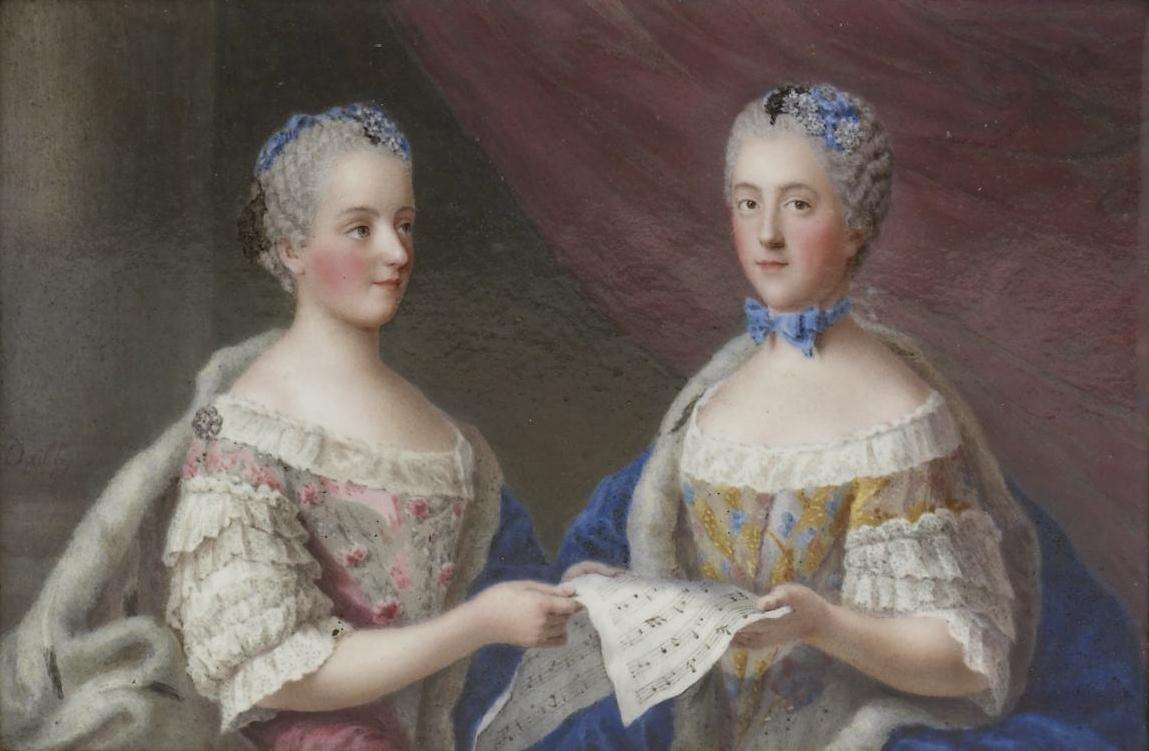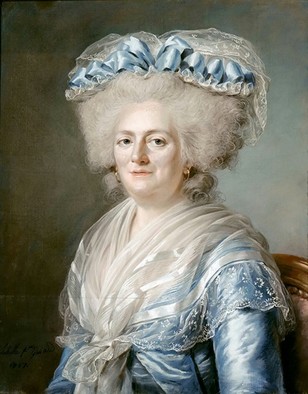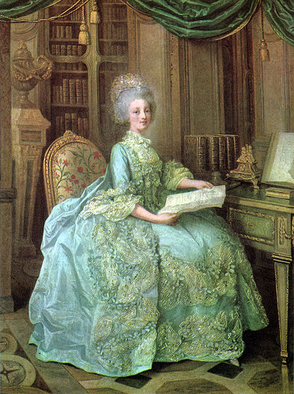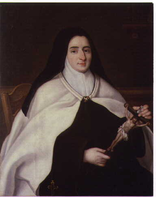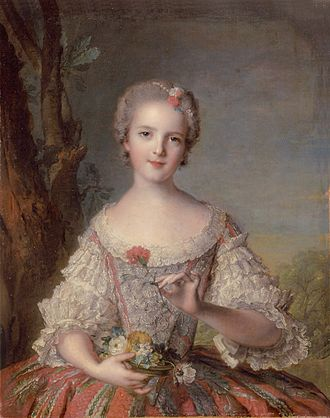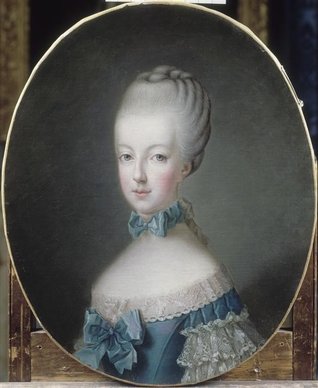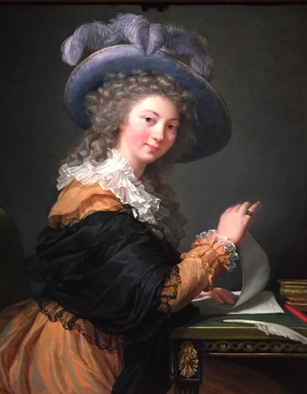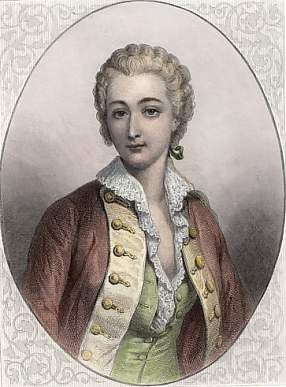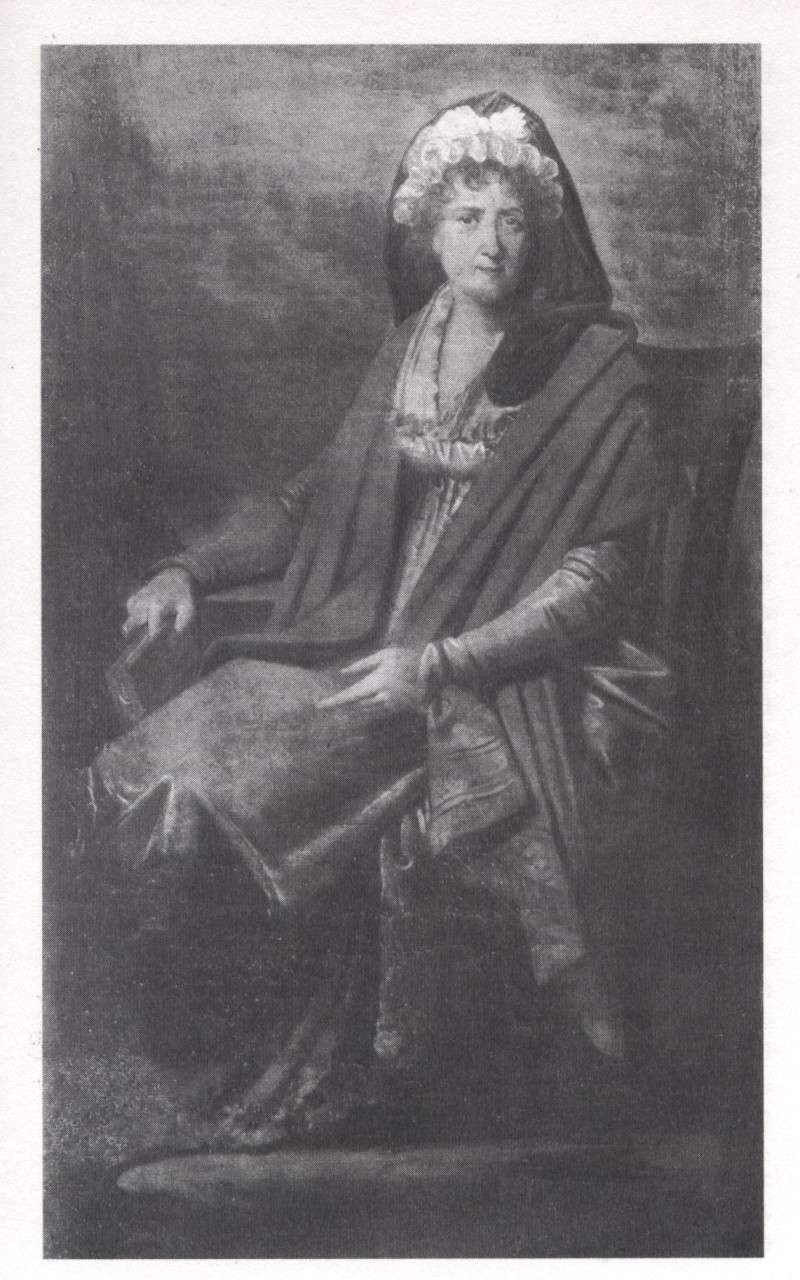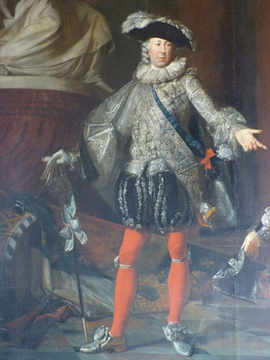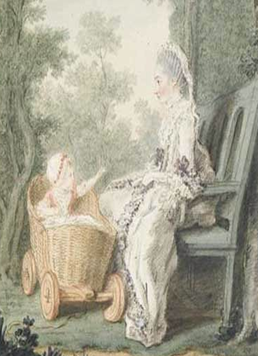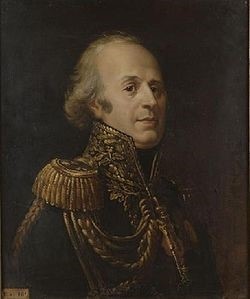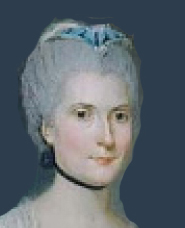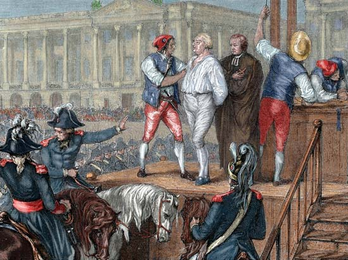Secondary Characters
Mesdames Victoire and Sophie
|
Collectively known as Mesdames Tantes, presumably after their nephew Louis XVI succeeded to the throne in 1774. Sophie and Victoire especially lived in the shadow of their older sister Adelaide, and while Sophie probably wasn't quite the shadow that I wrote her (or didn't write her!), not much survives of her life; the same goes for Victoire.
Though their lives might seem empty and boring to us now, they were probably content; though completely irrelevant, they still held some of the highest ranks at Court, and kept themselves entertained with their hobbies. They had close friendships with their attendants, and wanted for nothing. All that changed, of course, with the Revolution, but only Victoire and Adelaide survived to suffer that. This dual portrait of Victoire and Sophie dates to 1761, when Sophie would have been 27 and Victoire 28, though they seem younger than that. They're wearing the dreadful "sheep curls" hairstyle, which I think terribly unattractive! The two portraits below are of them in their later years, Victoire in blue and Sophie looking sweet in green. |
Madame Louise
|
Louise was cut from a different cloth than her two elder sisters and probably more closely resembled Adelaide in terms of personality. Despite her high spirits and intelligence, she still had to suffer the same strictures of life at Versailles as her sisters. Later in life - when she was 33 - she judged correctly that she would wield more influence from the convent over her increasingly religious father, as well as fulfill a genuine vocation, so she hopped ship in 1770 and joined the religious Order of the Carmelites.
At right she is a sweet little girl of 11, and below as the Prioress with the Carmelites. |
Marie Antoinette
|
What can I say here that hasn't already been said a hundred times about the most famous and most tragic French queen? One of the things that was really brought home to me while researching this book, is just how much her initial fatal missteps continued to haunt her later, and how the odds were ever stacked against her - it was like she couldn't catch a break.
Start with the fact she was Austrian, a nationality hated by many of the French, then take a rather flighty, light personality, add a lack of true friends and advisers, and couple it with endless intriguing that she was ill-equipped to even recognize - well, it all started off badly and continued on downhill. Poor woman. Here she is the year of her marriage, 1770, in a portrait by Jean Baptiste Charpentier. |
Jean Baptiste, Comte du Barry
|
The Roué himself. He was probably typical of thousands of men like him in that era – ambitious men from the slightly suspect petty nobility (it was fairly easy to add a “de” to your name and claim to be someone), scrounging around the edges of the inner circle, making a living by both legal means (he had some contracts to supply regiments, but that was an activity also with lots of opportunity for graft) and slightly illegal ones (pimping women and running a gambling parlor). He struck it rich with Jeanne, that’s for sure, but Louis XV wanted nothing to do with him and he was unofficially exiled first to Paris, then to Switzerland and then to Toulouse. He lived out his days in Toulouse until the Revolution. He was executed in 1794, at the ripe old age of 71 - he had a name he couldn't escape.
In The Enemies of Versailles he's called Barry, which isn't accurate, but since his first name was Jean, and I already had Jeanne… I had to find him another name. Jean-Ceres was another option (his full title was du Barry-Ceres) but that didn’t really connect to anything, so I opted for Barry. He was married twice, first to Ursule Dalmas de Vernongrese, about whom I could find nothing. Together they had a son Adolphe, who figures a bit in the book. Adolphe married well, to a member of the Rohan family, but the marriage was an unhappy one and he died, in England in 1778 in a duel. Apparently Barry had a second wife, though I am not 100% sure about this; this portrait of the lady in the magnificent blue feathered hat is by Vigée Le Brun and is of the Comtesse Du Barry de Cérés, who was born Anne Marie Thérèse de Rabaudy Montoussin (1759-1834) and apparently married our Barry when she was eighteen. This portrait was done in 1784, so she would have been 25. I'm curious as to why a society painter like Vigée LeBrun would be painting her, or what she was doing in Paris, given that her husband would still have been persona extremely non-grata at the French Court. His brother Guillaume who "married" Jeanne also lived out his life in Toulouse but managed to survive the Revolution and only died in 1811. There were many more du Barry relatives that were involved with Jeanne after 1774, but they didn't get included in the book for reasons I explain in Changes & Omissions. I could never find a picture of any of the male du Barrys, so here instead is a picture of Barry's protegee (Jeanne, of course!) dressed up in masculine riding habit -> |
Claire Françoise "Chon" du Barry
|
Is a very interesting character but there wasn’t much information I could find about her. There is a fiction book about her, but I didn’t want that to influence my portrayal of her, so I didn’t read it: Frederic LeNormand's
Mademoiselle Chon du Barry. As told in the book, she came from Toulouse to aid her brother’s launching of Jeanne into the palace. All the history books say she was brought in to teach Jeanne manners and such, but that’s just nonsense. Though she was a noble by birth, the world of the provincial petty nobility was miles away from the haute aristocracy of Versailles, and as a high-class courtesan, Jeanne would have had much more exposure to proper manners and etiquette than Chon. Chon was supposed to be shrewd and calculating, a nice counterfoil to Jeanne’s rather brainless joie de vivre. Chon shared Jeanne’s exile, and eventually took a lover, and lived at Louveciennes all the way up to 1793 (I had her leaving slightly earlier in the book). She was imprisoned in Toulouse in 1794, alongside her brothers, but survived and eventually died in 1809 in France. This is a **possible** portrait of her, of course from her later years. She had a younger sister called Jeanne-Marie-Marthe, nicknamed Bischi, who also was friends with Jeanne, especially in later years at Louveciennes. |
Louis Hercule Timoléon de Cossé-Brissac, 8th Duc de Brissac
|
Hercule was a fascinating man, sometimes called the arch-typical aristocrat of his time. He was well educated, interested in the arts and sciences, snobbish but open to new ideas, and had a certain penchant for reform – he could see France was going nowhere fast.
When the Revolution broke out, he elected not to go into exile - his duty, he maintained, was beside his king, as his ancestors had been for centuries. That decision cost him his life, and in a particularly gruesome way. I included the story of his head being thrown into Jeanne’s dining room, but it’s probably just legend, though it is indeed true he was torn to shreds that day after being transported to Versailles to attend his “trial”. I didn’t touch on it in the book (see Omissions ) but Jeanne apparently helped save his daughter by helping her get to England, and they became friends after that. The rather bizarre picture of him in full-on late 16th century costume is apparently because of a tradition in the military regiment which he led: they liked to dress in historical costume! Here is his wife, Diane Hortense Mazarini Mancini, in one of those charming pastels by Carmontelle. She was a lady-in-waiting to Marie Antoinette and apparently hated Jeanne (the story about them having to use separate staircases at his house in Paris is true!) Sadly, the baby and Hercule's only heir, died young only a year or so after this portrait. |
Louis Marie Jacques Amalric, Comte de Narbonne-Lara
|
Was the second son of the Duchesse de Narbonne, Adelaide's beloved and faithful lady-in-waiting. He figures as a young boy and man in The Enemies of Versailles, but eventually went on to become a very famous and respected general with Napoleon.
Mostly because of the physical resemblance, he was rumored to be Louis XV's bastard, but I don't think he was; the dates of his conception and birth don't match up with when his mother would have been at Versailles and by the side of the king. See more information at his mother's page here. |
The Marquise de Civrac
|
Anne Marie de la Faurie de Monbadon, Duchesse de Civrac and Victoire's beloved lady-in-waiting was a fascinating character. She was almost like the Becky Sharpe (from Vanity Fair) of her time, and though from humble roots she was able to break into the inner circle at Versailles, definitely an enormous achievement. Her life was straight out of a novel. Born in 1720 as Mlle de Monbadon, daughter of a notary, in 1744 she married a poor local "hobereau", as the provincial petty nobility were sometimes derisively called. Her husband Monsieur de Blagnac was a very lowly and distant member of the powerful Durfort family, and this was undoubtedly his main attraction for Anne Marie!
Armed with her marriage papers, she took a carriage to Paris, where she had her husband's genealogies scrutinized and confirmed that yes, he was distantly related to the family of Durfort-Lorges. Anne Marie went straight to the Marechal de Lorges and presented herself as a member of his family, and gradually wormed her way into the affections of his wife, who had no daughters of her own. She began calling herself Madame de Civrac, one of the secondary titles of that great family, and she entered service at Versailles as an extra lady (dame surnuméraire) in the household of Mesdames Les Cadettes (Victoire, Sophie et Louise) in 1751. Eventually became Victoire's dame d'honneur when Victoire's household was formed. She was as good at worming her way into Victoire's affection as she had been with her distant relations years before! She had two daughters who also served in Victoire's household, and Enemies features Angelique, the Comtesse de Chastellux. It was actually Angelique who was always distressingly (at least from Adelaide's perspective) pregnant; she had nine children in sixteen years. Anne Marie is entirely different from Marie Françoise de Pardaillan de Gondrin, marquise de Civrac, who and features briefly in Rivals, with Rosalie wondering why her fellow lady-in-waiting hated her so much. |
The Revolution
|
Not really a character per se, but certainly central to the last third of the book and the fates of all of the characters. One of the things I really enjoyed about writing this trilogy is the way it builds towards that seminal event. In The Sisters of Versailles, it was just a shadow on the horizon, creeping a little bit closer with The Rivals of Versailles, and then really hanging over The Enemies of Versailles.
From a research perspective it was really cool to start 70 years ahead of it and build towards it, and then, in the last third of The Enemies of Versailles, figuring out how it actually played out and what it would have felt like for Adelaide or Jeanne being witness to, or hearing about, some of the key events. And then of course experiencing it for themselves, either from exile or death. |

